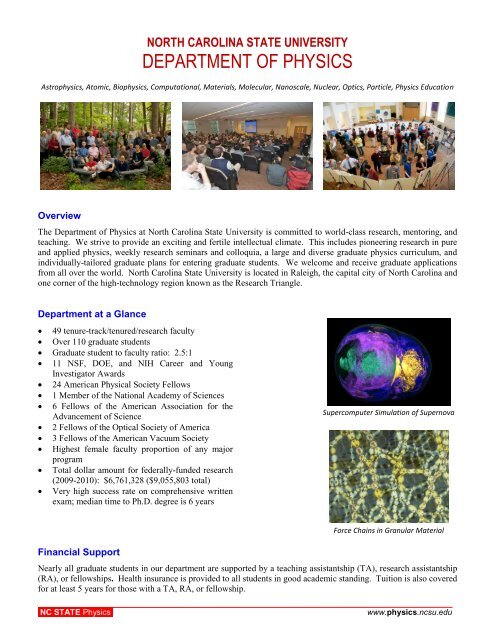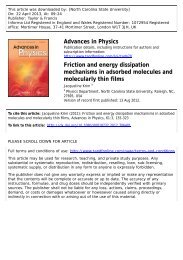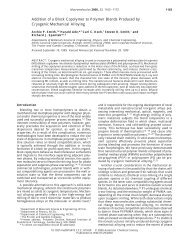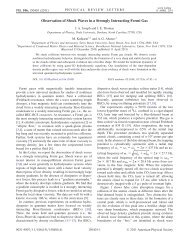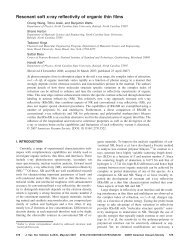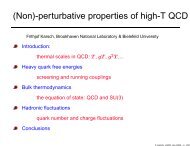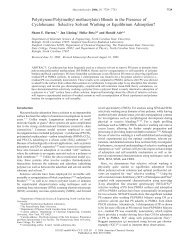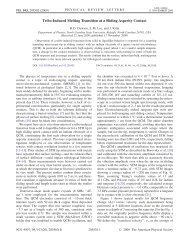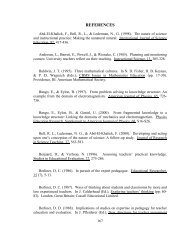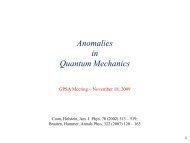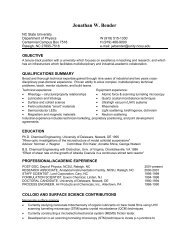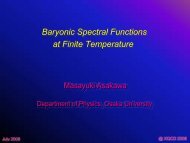Physics Graduate Brochure - Physics - North Carolina State University
Physics Graduate Brochure - Physics - North Carolina State University
Physics Graduate Brochure - Physics - North Carolina State University
Create successful ePaper yourself
Turn your PDF publications into a flip-book with our unique Google optimized e-Paper software.
NORTH CAROLINA STATE UNIVERSITY<br />
DEPARTMENT OF PHYSICS<br />
Astrophysics, Atomic, Biophysics, Computational, Materials, Molecular, Nanoscale, Nuclear, Optics, Particle, <strong>Physics</strong> Education<br />
Overview<br />
The Department of <strong>Physics</strong> at <strong>North</strong> <strong>Carolina</strong> <strong>State</strong> <strong>University</strong> is committed to world-class research, mentoring, and<br />
teaching. We strive to provide an exciting and fertile intellectual climate. This includes pioneering research in pure<br />
and applied physics, weekly research seminars and colloquia, a large and diverse graduate physics curriculum, and<br />
individually-tailored graduate plans for entering graduate students. We welcome and receive graduate applications<br />
from all over the world. <strong>North</strong> <strong>Carolina</strong> <strong>State</strong> <strong>University</strong> is located in Raleigh, the capital city of <strong>North</strong> <strong>Carolina</strong> and<br />
one corner of the high-technology region known as the Research Triangle.<br />
Department at a Glance<br />
49 tenure-track/tenured/research faculty<br />
Over 110 graduate students<br />
<strong>Graduate</strong> student to faculty ratio: 2.5:1<br />
11 NSF, DOE, and NIH Career and Young<br />
Investigator Awards<br />
24 American Physical Society Fellows<br />
1 Member of the National Academy of Sciences<br />
6 Fellows of the American Association for the<br />
Advancement of Science<br />
2 Fellows of the Optical Society of America<br />
3 Fellows of the American Vacuum Society<br />
Highest female faculty proportion of any major<br />
program<br />
Total dollar amount for federally-funded research<br />
(2009-2010): $6,761,328 ($9,055,803 total)<br />
Very high success rate on comprehensive written<br />
exam; median time to Ph.D. degree is 6 years<br />
Supercomputer Simulation of Supernova<br />
Financial Support<br />
Force Chains in Granular Material<br />
Nearly all graduate students in our department are supported by a teaching assistantship (TA), research assistantship<br />
(RA), or fellowships. Health insurance is provided to all students in good academic standing. Tuition is also covered<br />
for at least 5 years for those with a TA, RA, or fellowship.<br />
.NC STATE <strong>Physics</strong>.<br />
www.physics.ncsu.edu
<strong>Graduate</strong> Fellowships and Supplements for Excellence<br />
The <strong>North</strong> <strong>Carolina</strong> <strong>State</strong> <strong>University</strong> <strong>Physics</strong> Department is committed to providing fellowships and supplements for<br />
excellence to its incoming graduate students. Some recent examples include NSF <strong>Graduate</strong> Research Fellowships,<br />
the N.C. <strong>State</strong> Andrews Fellowship , and GAANN Fellowships. Outstanding U.S. applicants are eligible for these<br />
fellowships and a number of supplements for excellence. There are typically 10 nine-month awards, ranging in<br />
amounts from $8,000 to $22,000. The support is initially for one academic year, with possible renewal. Fellowships<br />
and supplements can reduce or eliminate teaching loads, allowing recipients to focus on accelerated coursework or to<br />
get an early start on research. Application target date for Fall 2014 applicants is January 9, 2014.<br />
Research Areas<br />
Our large and diverse research program covers most areas of forefront physics research<br />
Experimental:<br />
<br />
<br />
<br />
<br />
<br />
<br />
<br />
<br />
<br />
<br />
Atomic <strong>Physics</strong> and Quantum Optics<br />
Biophysics<br />
Electronic Materials<br />
Nanoscience and Materials<br />
Nuclear <strong>Physics</strong> (Triangle Universities Nuclear Laboratory)<br />
Optics<br />
<strong>Physics</strong> Education<br />
Soft Matter <strong>Physics</strong><br />
Synchrotron Radiation<br />
Thin Films<br />
Theoretical/Computational:<br />
<br />
<br />
<br />
<br />
<br />
<br />
Astrophysics<br />
Atomic <strong>Physics</strong><br />
Condensed Matter <strong>Physics</strong><br />
General Relativity<br />
Nuclear and Particle <strong>Physics</strong><br />
Nanoscience/Materials and Biomolecular Simulations<br />
(Center for High Performance Simulation)<br />
<strong>Graduate</strong> Student Life at NC <strong>State</strong><br />
Our graduate program has over 110 graduate students. Roughly one-half are from the U.S. and one-half are from<br />
other countries. In recent years the list of countries has included China, Germany, Great Britain, India, Iran, Jamaica,<br />
Japan, Korea, Russia, Thailand, Turkey, Ukraine, and the Virgin Islands. Our department is among the national<br />
leaders for the number of female and under-represented minority Ph.D. graduates in physics. While academically<br />
demanding, life as a physics graduate student at <strong>North</strong> <strong>Carolina</strong> <strong>State</strong> <strong>University</strong> offers a wide variety of social and<br />
recreational activities within the city of Raleigh and the surrounding Research Triangle area. Raleigh is located<br />
within two to four hours driving distance from the <strong>North</strong> <strong>Carolina</strong> beaches and Outer Banks on the east and the Blue<br />
Ridge, Smoky Mountains, and Appalachian Trail on the west.<br />
Further Information<br />
We encourage interested applicants to learn more through our webpage, www.physics.ncsu.edu. Prospective<br />
students can contact any faculty member directly or the <strong>Graduate</strong> Program office at<br />
py-grad-program@ncsu.edu. The NC <strong>State</strong> <strong>Physics</strong> Department has a listing in the American Institute of <strong>Physics</strong><br />
publication <strong>Graduate</strong> Programs in <strong>Physics</strong>, Astronomy, and Related Fields.<br />
Application deadline for priority consideration for Fall 2014: January 9, 2014<br />
.NC STATE <strong>Physics</strong>.<br />
www.physics.ncsu.edu
NORTH CAROLINA STATE UNIVERSITY<br />
DEPARTMENT OF PHYSICS<br />
<strong>Graduate</strong> Student Life – Work and Play<br />
Panorama View of NC <strong>State</strong> Belltower and Campus<br />
Life in the <strong>Physics</strong> Department<br />
What is it like to be a physics graduate student at NC <strong>State</strong> You can read about life in the physics department from<br />
our physics graduate student blog, gradblog.physics.ncsu.edu. Here are some comments posted by students.<br />
“...With that said, it is still possible to have some personal time. The social environment here at NCSU is very<br />
unique. Instead of the strict competition you might find at some schools, there is a much more welcoming and<br />
friendly environment to be found here. I came to Raleigh knowing literally no one, and already by my second<br />
semester, I have found a close group of friends. … I think it’s time to go hang out with them! Catch ya later!”<br />
“… I came to NC <strong>State</strong> <strong>University</strong> in 2008, right after I graduated from SJTU in Shanghai with a BS in <strong>Physics</strong> and<br />
Optics. After searching for a year in <strong>Physics</strong> Department, I finally settled down in Dr. Lucovsky's research group and<br />
stayed since then. My research topic is XANES (X-ray Absorption Near Edge Spectroscopy) of amorphous<br />
semiconductor, which involve both theoretical calculation and experiments. The theoretical side relies on group<br />
theory and ab initio methods while samples made in our group are tested at synchrotron facilities such as SSRL and<br />
NSLSL. In my leisure time, I participate in various activities from parties to skiing trips, mostly with my fellow<br />
physics students. While alone, I play video/PC games and read books, or visit museums sometimes. Life in Raleigh is<br />
good so far.”<br />
Entering Class of Fall 2011<br />
Court of <strong>Carolina</strong> on NC <strong>State</strong> Campus<br />
.NC STATE <strong>Physics</strong>.<br />
www.physics.ncsu.edu
Downtown Raleigh at Night Progress Energy Performing Arts Center<br />
Metropolitan Raleigh and the Research Triangle<br />
NC <strong>State</strong> <strong>University</strong> is located in Raleigh, the capital city of <strong>North</strong> <strong>Carolina</strong>, with a population of over one million in<br />
the Raleigh metropolitan region. NC <strong>State</strong> is one of the three Triangle universities which anchor the Research<br />
Triangle. The other Triangle universities are the <strong>University</strong> of <strong>North</strong> <strong>Carolina</strong> at Chapel Hill and Duke <strong>University</strong> in<br />
Durham. The Research Triangle is a national center for physics research, drawing upon synergies among the three<br />
Triangle universities and several hundred R&D companies and research institutes in Research Triangle Park and<br />
surrounding areas. Students may cross-register for advanced courses at any Triangle university and take advantage<br />
of numerous joint seminars and research institutes. The Research Triangle and Raleigh metropolitan area has<br />
garnered the following national accolades:<br />
■ #1 Best City – Bloomberg Businessweek 2011<br />
■ #1 Best Places for Business and Careers – Forbes 2011<br />
■ #1 Quality of Life – Portfolio.com 2010<br />
■ #1 Fastest Growing Metropolitan Region – US Census 2009<br />
■ #2 Brain Magnet in the Nation – Forbes 2011<br />
■ #4 Smartest Cities – US Census 2010<br />
The following quote is from Bloomberg Businessweek 2011:<br />
“… To most residents of Raleigh, it may not come as a surprise that their city earned the title of America's Best City.<br />
Raleigh shows the cultural graces that go along with anchoring the so-called research triangle, home to <strong>North</strong><br />
<strong>Carolina</strong> <strong>State</strong> <strong>University</strong>, ... Among its many attributes the city sports 867 restaurants, 110 bars, and 51 museums,<br />
according to Onboard Informatics, as well as a thriving social scene, good schools, and 12,512 park acres, equal to<br />
several times the green space per capita in cities like New York and Los Angeles, according to the Trust for Public<br />
Land. It also offers a great deal on nights and weekends--from concerts and opera, to the NHL's <strong>Carolina</strong><br />
Hurricanes and college sports, to the 30,000-sq.-ft. <strong>State</strong> Farmers Market.” ____________________________<br />
Raleigh Little Theater and Rose Garden<br />
Lake Wheeler<br />
.NC STATE <strong>Physics</strong>.<br />
www.physics.ncsu.edu
NORTH CAROLINA STATE UNIVERSITY<br />
DEPARTMENT OF PHYSICS<br />
Astrophysics<br />
Blondin•Borkowski•Brown•Ellison•Fröhlich•Kneller•Lazzati•McLaughlin•Reynolds<br />
Overview<br />
The astrophysics group at <strong>North</strong> <strong>Carolina</strong> <strong>State</strong><br />
<strong>University</strong> investigates a range of topics within the<br />
broad category of high-energy astrophysics. Research<br />
includes observations with space-based observatories,<br />
analytical and numerical modeling, and large-scale<br />
numerical simulations. In addition to work described<br />
below, topics include Big Bang nucleosynthesis,<br />
galactic chemical evolution, stellar winds, interacting<br />
binary stars, accretion disks, and pulsar wind nebulae.<br />
Our research is funded by NASA, NSF, and DOE.<br />
Research Areas<br />
Supernovae and Gamma-Ray Bursts represent<br />
the most violent explosions in our universe. The<br />
gravitational collapse of the stellar core in both of<br />
these events is expected to break spherical symmetry<br />
and lead to a strong source of gravitational waves.<br />
Prof. Brown works to develop analytical and<br />
numerical tools that can be used to investigate these<br />
strongly gravitating systems and predict the<br />
gravitational radiation emitted by SNe and GRBs.<br />
Prof. Lazzati studies the theory of long-duration<br />
GRBs, believed to be produced by relativistic jets of<br />
plasma ejected in the core of massive stars at the end<br />
of their evolutionary cycle. He studies the<br />
mechanisms for the energy release in the core of the<br />
star, the physics of the jet propagation, the emission of<br />
the prompt radiation, and the afterglow emission.<br />
Prof. Blondin works with the CHIMERA<br />
collaboration to develop full-physics threedimensional<br />
numerical simulations of core-collapse<br />
supernovae. His particular interest is in understanding<br />
the origin of the Spherical Accretion Shock<br />
Instability, and its role in driving supernova<br />
explosions. Prof. Fröhlich’s interests include the roles<br />
of nuclear structure, the equation of state of bulk<br />
.NC STATE <strong>Physics</strong>.<br />
nuclear matter, plasma dynamics, and neutrino<br />
transport. Profs. Kneller and McLaughlin study the<br />
evolving flavor composition of neutrinos as they<br />
propagate through supernovae and how various<br />
mechanisms that drive that evolution manifest<br />
themselves in the signal expected when we next detect<br />
the burst from a galactic supernova. From this signal<br />
one can hope to tease out the unknown properties of<br />
the neutrino such as the ordering of the neutrino<br />
masses, the size of the last mixing angle and the CP<br />
phase.<br />
X-ray observations by Reynolds in the constellation<br />
Sagittarius discovered the remains of the most recent<br />
supernova in our galaxy<br />
Supernova Remnants (SNRs) are a focus of<br />
research at NCSU, from detection of scandium in<br />
G1.9+0.3, the youngest supernova in our galaxy, to<br />
the role of dynamical instabilities in disrupting the<br />
oldest SNRs in our galaxy like the Cygnus Loop.<br />
Profs. Borkowski and Reynolds use various spacebased<br />
observatories to study SNRs, in X-rays with the<br />
Chandra, XMM-Newton, and Suzaku satellites, and in<br />
infrared with NASA's Spitzer Space Telescope. X-ray<br />
emission includes thermal emission, providing<br />
information on remnant ages, energetics, and<br />
www.physics.ncsu.edu
elemental composition; and nonthermal, synchrotron<br />
emission from extremely energetic electrons, giving<br />
information on the shock acceleration process which<br />
is probably responsible for producing galactic cosmic<br />
rays. Prof. Ellison studies the acceleration of these<br />
particles via the Diffusive Shock Acceleration<br />
mechanism including nonlinear effects of particle<br />
acceleration on the shock dynamics. Prof. Blondin<br />
uses hydrodynamic simulations to study the evolution<br />
of SNRs, the role of instabilities in mixing heavyelement<br />
ejecta with circumstellar gas, and the<br />
formation of large-scale asymmetries. Prof. Reynolds<br />
models synchrotron emission at radio and X-ray<br />
wavelengths from shell SNRs as well as from pulsarwind<br />
nebulae, "bubbles" of relativistic electrons and<br />
magnetic field produced by pulsars. Both the spatial<br />
distribution and the spectrum of this emission contain<br />
information important for understanding how particles<br />
are accelerated to high energies in astrophysical shock<br />
waves, and how pulsars produce their relativistic<br />
winds of material.<br />
Cosmic Rays are the highest energy particles<br />
observed from space. Prof. Ellison studies the<br />
production of energetic particles in shock waves in a<br />
variety of astrophysical sites via the Diffusive Shock<br />
Acceleration mechanism. Shock acceleration is highly<br />
efficient and nonlinear and most work involves<br />
modeling this mechanism with computer simulations.<br />
Cosmic rays affect nuclear abundances through a<br />
process known as spallation, where a relativistic<br />
proton can shatter a heavy nucleus such as oxygen to<br />
produce lighter elements. Prof. Kneller aims to better<br />
understand the sources of cosmic rays, their evolution,<br />
and the environment where spallation occurs.<br />
Dust is a primary source of infrared emission from a<br />
variety of astrophysical objects. Astronomical dust is<br />
one of the least understood components of the<br />
interstellar medium. Profs. Borkowski and Reynolds<br />
use infrared emission to infer the properties of dust in<br />
SNRs and to understand grain destruction in hot,<br />
shocked plasma. Prof. Lazzati’s research focuses on<br />
the mechanisms of dust nucleation, the process of<br />
forming the seeds of dust particles (usually micrograins<br />
with only several tens of atoms in them) from<br />
purely gaseous compounds.<br />
Computational Astrophysics is an over-arching<br />
theme in the astrophysics group at NCSU. Prof.<br />
Ellison uses Monte-Carlo techniques to model nonlinear<br />
effects in shock waves. Prof. Brown is<br />
developing numerical algorithms for the Einstein<br />
equations and using numerical simulations to model<br />
gravitational wave production in binary black hole<br />
systems. Profs. Fröhlich, Kneller and McLaughlin use<br />
nuclear reaction network codes and neutrino transport<br />
algorithms to study nucleosynthesis and neutrino<br />
flavor mixing in a variety of astrophysics applications.<br />
Profs. Blondin and Lazzati use large-scale 3D<br />
hydrodynamic and magnetohydrodynamic simulations<br />
to study systems ranging from stellar winds to GRBs.<br />
Computing resources used by our group range from a<br />
dedicated local linux cluster to national<br />
supercomputers including DOE’s Jaguar at the<br />
National Center for Computational Sciences, NASA’s<br />
Pleiades and several NSF TeraGrid systems.<br />
Further Information<br />
We encourage interested applicants to learn more through the astrophysics group webpage, astro.physics.ncsu.edu.<br />
Prospective students can contact the <strong>Graduate</strong> Program office at py-grad-program@ncsu.edu or any faculty member<br />
directly. The email addresses are as follows:<br />
john_blondin@ncsu.edu<br />
kborkow@ncsu.edu<br />
david_brown@ncsu.edu<br />
don_ellison@ncsu.edu<br />
carla_frohlich@ncsu.edu<br />
jim_kneller@ncsu.edu<br />
davide_lazzati@ncsu.edu<br />
gail_mclaughlin@ncsu.edu<br />
steve_reynolds@ncsu.edu<br />
.NC STATE <strong>Physics</strong>.<br />
www.physics.ncsu.edu
NORTH CAROLINA STATE UNIVERSITY<br />
DEPARTMENT OF PHYSICS<br />
Biophysics<br />
Overview<br />
The biological physics group at <strong>North</strong> <strong>Carolina</strong> <strong>State</strong><br />
<strong>University</strong> uses experimental, theoretical and<br />
computational approaches to investigate a wide range<br />
of biological problems. We are interested in processes<br />
that span molecular level phenomena through cellular<br />
systems and all the way to living organisms. We are<br />
addressing questions relevant to human health that<br />
include protein folding, structural biology, enzymatic<br />
biochemistry, protein-DNA interactions, cell signaling<br />
pathways and epigenetics.<br />
biological molecules that combines advanced<br />
mathematical techniques with the power of parallel<br />
computers. A real-space multigrid method, developed<br />
at NCSU, enables ab initio studies of very large<br />
systems. A recently developed hybrid real-space<br />
method enables accurate, quantum-mechanical<br />
simulations of large solvated biomolecules and of<br />
biomolecular aspects of human diseases. The first<br />
applications of this method concern the role of copper<br />
in prion and Parkinson diseases. Continued research<br />
focuses on the role of transition metals in human<br />
metabolism and diseases. (bernholc@ncsu.edu)<br />
Hans Hallen<br />
Prof. Hallen's interest in biophysics centers on probebased<br />
optical devices as sensors or agents. In the latter<br />
case, the induced phenomenon would be studied in<br />
conjunction with standard microscopic cellular<br />
biology techniques. The group developed a nano-bio<br />
sensor that can apply nano-defined light or electric<br />
field. This has been made biocompatible and is also<br />
able to manipulate a nucleus within a cell or between<br />
cells. (hans_hallen@ncsu.edu)<br />
Our work is funded by the National Institutes of<br />
Health, the National Science Foundation, the<br />
Department of Energy and private organizations like<br />
the American Cancer Society. Our approach is highly<br />
interdisciplinary, often involving close collaborations<br />
with scientists in the medical schools at Duke and<br />
UNC Chapel Hill, and other universities and national<br />
labs. Our group co-hosts the weekly Soft Condensed<br />
Matter and Biophysics seminar series. Our faculty,<br />
staff, and student offices are located in Riddick Hall.<br />
Faculty Members and Research Interests<br />
Jerzy Bernholc<br />
Prof. Bernholc uses sophisticated computational<br />
methodology for electronic structure calculations of<br />
.NC STATE <strong>Physics</strong>.<br />
Shuang Fang Lim<br />
Prof. Lim’s work focuses on DNA methylation<br />
analysis and chromatin histone modifications of rare<br />
earth doped nanoparticles. Her research includes<br />
synthesis of nanoparticles, bioconjugation, their<br />
photophysics and bio-applications such as biosensors<br />
and biotherapeutic agents. She also works on the<br />
epigenetic mapping of DNA and chromatin.<br />
(sflim@ncsu.edu)<br />
Robert Riehn<br />
Prof. Riehn is interested in the physics of biological<br />
molecules in nano-scale environments. In particular,<br />
DNA can be efficiently manipulated by confining it to<br />
channels with a cross-section that is on the order of<br />
www.physics.ncsu.edu
the DNA persistence length (50 nm). His work<br />
develops novel techniques in nanobiotechnology,<br />
using nanoconfined DNA to solve biological puzzles.<br />
Prof. Riehn’s research combines nanotechnology with<br />
polymer physics to provide innovative technologies<br />
for biological analysis. He is particularly interested in<br />
the individuality of large-scale genetic functions<br />
during development and in cancers, and has developed<br />
techniques for determining the epigenetic state of<br />
individual genomic-size DNA fragments.<br />
(rriehn@ncsu.edu)<br />
Christopher Roland<br />
Prof. Roland’s research centers on exploring<br />
properties of nanoscale materials and biomolecules.<br />
Most recent interests have focused on (i)<br />
methodological developments for multiscale,<br />
biomolecular simulations; (ii) quantum transport<br />
through nanoscale devices; (iii) action and function of<br />
select biomolecules; and (iv) physics of carbon<br />
nanotube and related systems. To explore the<br />
interesting physics of these systems, he uses a range<br />
of computational methods such as quantum chemistry,<br />
density functional theory, classical molecular<br />
dynamics, phase field models, and kinetic Monte<br />
Carlo simulations, all coupled with the principles of<br />
statistical mechanics. (cmroland@ncsu.edu)<br />
Celeste Sagui<br />
Prof. Sagui’s research interests include statistical<br />
mechanics, condensed matter theory and complex<br />
systems, phase separation and nucleation processes,<br />
and computational biology and biomolecular<br />
simulations. Recent work has focused on<br />
methodological developments for the accurate and<br />
efficient treatment of electrostatics, and free-energy<br />
methods for large-scale biomolecular simulations.<br />
Resulting codes have been implemented in the<br />
AMBER package, of which Prof. Sagui is a co-author.<br />
Recent systems under study include nucleic acids and<br />
proteins, solvation, modulated condensed matter<br />
systems for nanotechnological applications, antibiotics<br />
and metalloproteins. To explore properties of these<br />
systems, she uses a range of computational methods<br />
such as quantum chemistry, density functional theory,<br />
classical molecular dynamics, phase field models and<br />
hydrodynamics equations. (celeste_sagui@ncsu.edu)<br />
Hong Wang<br />
Prof. Wang’s research centers on single-molecule<br />
experimental investigations of the structure-function<br />
relationships that govern the maintenance of<br />
telomeres, which are nucleoprotein structures that cap<br />
the ends of linear chromosomes. Her lab uses two<br />
complementary single-molecule imaging techniques<br />
(atomic force microscopy and fluorescence imaging)<br />
along with quantum dot labeled proteins. The goal of<br />
her current research is to investigate the effects of<br />
DNA damage on the conformational and dynamic<br />
properties of telomeric DNA structure and telomere<br />
binding proteins. (hong_wang@ncsu.edu)<br />
Keith Weninger<br />
Prof. Weninger’s research interests are focused on<br />
experimentally revealing the molecular mechanisms at<br />
work in complex biological systems with the use of<br />
single molecule, optical spectroscopy. His lab uses a<br />
variety of optical techniques (including single<br />
molecule FRET, single particle tracking, and<br />
fluorescence quenching) that are capable of resolving<br />
the real-time dynamical motion of individual<br />
biological molecules. Current efforts are addressing<br />
aspects of protein folding, membrane fusion<br />
phenomena, and DNA mismatch repair processes.<br />
(keith_weninger@ncsu.edu)<br />
Further Information<br />
We encourage interested applicants to learn more through the biophysics group webpage,<br />
www.physics.ncsu.edu/research/biophysics_and_soft_condensed_matter.html and the webpages of the<br />
individual researchers linked from there. Prospective students can contact any faculty member directly (see email<br />
addresses above) or the <strong>Graduate</strong> Program office at py-grad-program@ncsu.edu.<br />
.NC STATE <strong>Physics</strong>.<br />
www.physics.ncsu.edu
NORTH CAROLINA STATE UNIVERSITY<br />
DEPARTMENT OF PHYSICS<br />
Experimental Nuclear <strong>Physics</strong><br />
Overview<br />
The experimental nuclear group is active in studies of<br />
fundamental symmetries of neutrons and nuclei,<br />
particle astrophysics, and a variety of applied topics in<br />
nuclear structure and nuclear technology. One of the<br />
focus areas for the group is experiments which utilize<br />
ultracold neutrons, where the NCSU group plays a<br />
leading role in the neutron static electric dipole<br />
moment (nEDM) experiment; in several innovative,<br />
high precision measurements of neutron beta-decay<br />
(UCNA and the NIST lifetime experiment); and in the<br />
development of next generation ultracold neutron<br />
sources. We are also involved in neutrinoless double<br />
beta-decay and dark matter experiments, nuclear<br />
structure measurements on a wide variety of nuclei<br />
and nuclear systems, and some research directed to<br />
applications of nuclear technology for engineering and<br />
industrial problems.<br />
Our faculty are members of the Triangle Universities<br />
Nuclear Laboratory (TUNL), a DOE Center of<br />
Excellence which offers a unique suite of low energy,<br />
polarized particle beams, the High Intensity Gamma-<br />
Ray Source, and cryogenic facilities for local<br />
experiments. On the NCSU campus, we also perform<br />
research at the PULSTAR reactor, where we are<br />
building a world-class ultracold neutron source. We<br />
plan to build a small scale version of the neutron<br />
electric dipole moment experiment, using ultra-cold<br />
neutrons from this source. Our research is funded by<br />
the Department of Energy and the National Science<br />
Foundation.<br />
Faculty Members and Research Interests<br />
Robert Golub<br />
Prof. Golub’s research interests include symmetry<br />
violations, in particular T violation and the search for<br />
a neutron electric dipole moment. Much of his current<br />
research involves the use of ultracold neutrons as a<br />
tool for applied and fundamental research. Another<br />
common theme is the use of low energy particle spin<br />
dynamics, including NMR techniques and applications<br />
.NC STATE <strong>Physics</strong>.<br />
www.physics.ncsu.edu
to exotic neutron scattering instruments. His current<br />
experimental work is focused on ultracold neutrons,<br />
3 He NMR, and the development of imaging<br />
techniques for the nEDM project. He is also working<br />
on the design and construction of an apparatus to<br />
study the interaction of UCN with 3 He as a prototype<br />
for the search for the nEDM project.<br />
(rgolub@ncsu.edu)<br />
David Haase<br />
Prof. Haase employs experimental techniques in low<br />
temperature and condensed matter physics in the study<br />
of the properties of neutrons and nuclei. He and his<br />
students have constructed refrigerators and devices to<br />
polarize nuclear targets for neutron scattering<br />
experiments. His current project is the development<br />
of the cryogenic systems for the neutron electric<br />
dipole moment (nEDM) experiment that is being<br />
prepared for construction at Oak Ridge National<br />
Laboratory. (david_haase@ncsu.edu)<br />
Paul Huffman<br />
Prof. Huffman is the technical coordinator and deputy<br />
contract project manager for the nEDM project. He is<br />
also the leader of the NIST lifetime experiment, which<br />
magnetically traps ultracold neutrons produced in<br />
superfluid helium and then measures their decay in<br />
situ to extract the neutron lifetime. Prof. Huffman is<br />
also involved in the development of the fundamental<br />
nuclear physics beamline at the Spallation Neutron<br />
Source at Oak Ridge National Laboratory. His<br />
research spans a wide range of neutron-related topics,<br />
and also includes the measurement of coherent<br />
scattering amplitudes in low-Z nuclei, fundamental<br />
symmetries tests in nuclei, and the use of thermal<br />
neutrons for 3D imaging. (paul_huffman@ncsu.edu)<br />
John Kelley<br />
At the Triangle Universities Nuclear Laboratory, Prof.<br />
Kelley is involved in research utilizing the High<br />
Intensity Gamma-Ray Source (HIGS). In the tandem<br />
laboratory, neutron beam experiments are carried out<br />
to refine neutron reaction cross sections that are<br />
essential for projects in energy generation, national<br />
security, transmutation of waste, and basic research.<br />
At HIGS, high-resolution studies using Nuclear<br />
Resonance Fluoresence techniques (NRF) are<br />
searching for new levels. The beams from HIGS<br />
provide an excellent tool for discovering levels and<br />
characterizing their properties. In addition to studies<br />
of nuclei in the actinide region, recent NRF studies<br />
have focused on characterizing the pygmy dipole<br />
resonance, which is a collective excitation mode in<br />
some neutron-rich nuclei. He is also active in the<br />
Data Evaluation Group at the Triangle Universities<br />
Nuclear Laboratory. (kelley@tunl.duke.edu)<br />
Albert Young<br />
Prof. Young’s research uses neutrons and nuclei to<br />
probe aspects of the particle physics standard model.<br />
He helps lead the UCNA project at Los Alamos,<br />
which measures angular correlations in neutron decay<br />
using ultracold neutrons. He also helped develop the<br />
solid deuterium ultracold neutron source at Los<br />
Alamos (the only operating source of extracted<br />
ultracold neutrons in the U.S.), and he is involved in<br />
the construction of an ultracold neutron source at the<br />
PULSTAR reactor on NCSU campus. His research<br />
interests include neutrinoless double beta-decay,<br />
symmetry tests in nuclear beta-decay and some<br />
biomedical applications. (albert_young@ncsu.edu)<br />
Further Information<br />
We encourage interested applicants to learn more through the experimental nuclear physics group webpage,<br />
http://www.physics.ncsu.edu/experimentalnuclearphysics. Prospective students can contact any faculty member<br />
directly (see email addresses above) or the <strong>Graduate</strong> Program office at py-grad-program@ncsu.edu.<br />
.NC STATE <strong>Physics</strong>.<br />
www.physics.ncsu.edu
NORTH CAROLINA STATE UNIVERSITY<br />
DEPARTMENT OF PHYSICS<br />
Nanoscale and Materials Simulations<br />
Overview<br />
The nanoscale and materials simulations group<br />
investigates a wide range of topics including large<br />
scale simulations of materials, bio-molecular<br />
processes, semiconductors, nanotubes and related<br />
nanoscale structures; quantum Monte Carlo<br />
simulations; multiscale methods; quantum transport;<br />
nanostructured materials; phase separation; ferrofluid<br />
liquid-state theory; interfaces; diffusion pattern<br />
formation; electronic properties of transition-metal<br />
oxides and silicates.<br />
The group benefits from many collaborations with<br />
colleagues in several departments at NC <strong>State</strong><br />
<strong>University</strong> as well as many other universities and<br />
research laboratories. The nanoscale and materials<br />
simulations group is also an integral part of the Center<br />
for High Performance Simulation at NC <strong>State</strong> which<br />
brings together faculty, postdocs, and students in the<br />
College of Engineering and College of Physical and<br />
Mathematical Sciences in electronic, atomic, mesoscale,<br />
and macroscopic simulation methods. The<br />
Center for High Performance Simulation is directed<br />
by Prof. Jerzy Bernholc in <strong>Physics</strong> and Prof. Keith<br />
Gubbins in Chemical Engineering.<br />
Faculty Members and Research Interests<br />
Jerzy Bernholc<br />
Prof. Bernholc is working in several subfields of<br />
theoretical condensed matter, materials physics, and<br />
biophysics. In the area of semiconductors, this<br />
includes the theory of defects, impurities, diffusion,<br />
semiconductor surfaces and steps, and surface optical<br />
properties. In the emerging field of fullerenes, his<br />
contributions include predictions of fundamental<br />
properties of solid C 60 soon after its discovery.<br />
Another area of research is new methodology for<br />
electronic structure calculations using advanced<br />
mathematical techniques and massive parallel<br />
computing. His current research focuses on nanoscale<br />
science and technology, nano and molecular<br />
electronics, energy storage mechanisms, the role of<br />
transition metals in human metabolism and diseases,<br />
and algorithms and methodology of high-performance<br />
scalable parallel computing. (bernholc@ncsu.edu)<br />
.NC STATE <strong>Physics</strong>.<br />
www.physics.ncsu.edu
Lubos Mitas<br />
Prof. Mitas' research includes many-body<br />
computational methods for quantum systems, ab initio<br />
calculations of electronic structure, fundamental<br />
properties of many-body wavefunctions, variational<br />
and quantum Monte Carlo methods, and the<br />
theoretical prediction and analysis of new clusters,<br />
molecules, and solids. Some of his recent work<br />
includes structural properties of transition metal<br />
oxides under pressure, electronic and atomic<br />
structures of transition metal nanoparticles, theory of<br />
pfaffian pairing wavefunctions, structure of fermion<br />
nodes and nodal cells, excitations in silane and<br />
methane molecules, silicon nanoparticles,<br />
ferromagnetism in hexaborides, and electron<br />
correlations in carbon rings.<br />
(lubos_mitas@ncsu.edu)<br />
Christopher Roland<br />
Prof. Roland explores the properties of nanoscale<br />
materials and biomolecules. Recent topics include<br />
methods for multiscale biomolecular simulations,<br />
quantum transport in nanoscale devices; the dynamics<br />
and biological function of certain biomolecules, and<br />
the physics of nanotubes. Several recent studies<br />
include pattern formation and strain-induced<br />
instabilities in modulated systems, first-principles<br />
calculations of capacitance in carbon nanotubes,<br />
Schottky barriers in carbon and boron nitride nanotube<br />
devices, and quantum transport through short<br />
semiconducting nanotubes. (cmroland@ncsu.edu)<br />
Celeste Sagui<br />
Prof. Sagui's research interests include statistical<br />
mechanics, condensed matter theory and complex<br />
systems, phase separation and nucleation processes,<br />
computational biology and biomolecular simulations.<br />
Recent work has focused on the accurate and efficient<br />
treatment of electrostatics and free-energy methods<br />
for large-scale biomolecular simulations. Some<br />
systems under study include structure and transitions<br />
of nucleic aids and proteins, molecular and ion<br />
solvation, modulated condensed matter systems for<br />
nanotechnological applications, antibiotics and<br />
metalloproteins. To explore the properties of these<br />
systems, Prof. Sagui uses a range of computational<br />
methods including quantum chemistry, density<br />
functional theory, classical molecular dynamics, phase<br />
field models, and hydrodynamics.<br />
(celeste_sagui@ncsu.edu)<br />
Carbon nanotube aligned with atoms of a<br />
graphite sheet exhibits good current flow<br />
Three-dimensional slice of the 59-dimensional<br />
node of electronic wavefunction of solid nitrogen<br />
Further Information<br />
Prospective students can contact any faculty member directly (see email addresses above) or the <strong>Graduate</strong> Program<br />
office at py-grad-program@ncsu.edu.<br />
.NC STATE <strong>Physics</strong>.<br />
www.physics.ncsu.edu
NORTH CAROLINA STATE UNIVERSITY<br />
DEPARTMENT OF PHYSICS<br />
Nanoscience, Electronic Materials, and Thin Films<br />
Overview<br />
The nanoscience, electronic materials, and thin films<br />
group at <strong>North</strong> <strong>Carolina</strong> <strong>State</strong> <strong>University</strong> studies a<br />
wide range of topics covering fields as diverse as<br />
nanotribology and X-ray absorption spectroscopy.<br />
With research in a variety of nanoscience programs,<br />
faculty members have interests that overlap with<br />
others in the department and extend to many<br />
departments and colleges in the university. Funding<br />
comes from a variety of sources including the<br />
National Science Foundation, the Department of<br />
Energy, and various agencies of the Department of<br />
Defense as well as industrial sponsors.<br />
Faculty Members and Research Interests<br />
David Aspnes<br />
Prof. Aspnes’ research focuses on optical<br />
spectroscopy of semiconductors and surface physics.<br />
Contributions include the discovery, elucidation, and<br />
development of low-field electroreflectance for highresolution<br />
spectroscopy of semiconductors and the<br />
determination of their band structures; the<br />
development and application of spectroscopic<br />
ellipsometry to the analysis of surfaces, interfaces,<br />
thin films, and bulk materials; and the development<br />
and application of reflectance-difference spectroscopy<br />
for the real-time analysis of epitaxial growth.<br />
Research activities are directed toward nondestructive<br />
analysis of surfaces, interfaces, and bulk materials,<br />
high precision determination of energy band critical<br />
points by reciprocal space analysis, properties of Si<br />
surfaces and interfaces, propagation of short optical<br />
.NC STATE <strong>Physics</strong>.<br />
pulses, and the development of methods of realizing<br />
real-time diagnostics and control of semiconductor<br />
epitaxy by organometallic chemical vapor deposition.<br />
(aspnes@ncsu.edu)<br />
Daniel Dougherty<br />
Prof. Dougherty and his research team study the<br />
physics of solid surfaces. They are particularly<br />
interested in pushing the spectroscopic capabilities of<br />
the scanning tunneling microscope for versatile<br />
nanomaterials characterization. Current research<br />
topics include spin transport in organic films;<br />
structure, morphology, and electronic properties at<br />
organic semiconductor interfaces; and the growth and<br />
electronic characterization of nanoporous metal-ligand<br />
surface networks. As participants in the NC <strong>State</strong><br />
Center for Molecular Spintronics, Dougherty’s group<br />
is working to establish the basic surface science of<br />
organic spintronic molecules adsorbed on magnetic<br />
surfaces and is working to characterize the<br />
implications of the coordination bonding for<br />
electronic properties of molecular assemblies using<br />
scanning tunneling spectroscopy.<br />
(dbdoughe@ncsu.edu)<br />
Kenan Gundogdu<br />
Prof. Gundogdu’s research is aimed at investigation of<br />
structural and electronic dynamics in condensed<br />
matter systems using ultrafast and nonlinear optical<br />
spectroscopy techniques. Specifically the focus is on<br />
the dynamics that are relevant to solar energy<br />
conversion. Some research questions include what is<br />
the role of coherent and incoherent electron motion in<br />
energy conversion, how does energy transport happen<br />
in interfaces that involve inorganic and organic<br />
materials, and what are the physical properties of<br />
optical excitations in such hybrid materials<br />
(kenan_gundogdu@ncsu.edu)<br />
www.physics.ncsu.edu
Jacqueline Krim<br />
Prof. Krim heads the Nanoscale Tribology Laboratory<br />
located in Partners III on Centennial Campus. Her<br />
research interests include solid-film growth processes<br />
and topologies at submicron length scales, liquid-film<br />
wetting phenomena, and nanotribology (the study of<br />
friction, wear, and lubrication at nanometer length and<br />
time scales). Research in Prof. Krim’s laboratory<br />
spans a variety of investigations including quartz<br />
crystal microbalance studies of atomic scale friction;<br />
multifunctional extreme environment surfaces;<br />
hydrodynamic lubrication in fiber processing; and<br />
nanotribology for air and space. The Krim group is a<br />
major participant in the National Science<br />
Foundation’s Center for Radio Frequency<br />
Microelectromechanical Systems Reliability and<br />
Design Fundamentals. (jackie_krim@ncsu.edu)<br />
Gerald Lucovsky<br />
Prof. Lucovsky’s research activities are in the<br />
deposition of thin film electronic materials using<br />
remote plasma enhanced chemical vapor deposition.<br />
Materials being studied include silicon oxide, silicon<br />
nitride, and silicon oxynitride; amorphous,<br />
microcrystalline, and crystalline silicon and silicon<br />
alloys; and crystalline gallium nitride and gallium<br />
phosphide. A second area of research deals with<br />
studies of the properties of thermally grown silicon<br />
dioxide and comparisons with plasma deposited<br />
oxides. These programs couple basic studies of<br />
materials synthesis and characterization with device<br />
applications. (lucovsky@ncsu.edu)<br />
Michael Paesler<br />
Prof. Paesler investigates semiconductors using<br />
extended X-ray absorption fine structure (EXAFS).<br />
Current research focuses on a family of phase change<br />
memory (PCM) materials that exhibit dramatic<br />
material property changes when switched between<br />
their amorphous and crystalline states. While these<br />
materials hold considerable promise in a variety of<br />
applications, the fundamental changes involved with<br />
the amorphous-crystalline transition are not well<br />
understood. The Paesler group studies PCM samples<br />
using EXAFS at national synchrotron facilities such as<br />
the National Synchrotron Light Source at Brookhaven<br />
National Laboratory and the Advanced Photon Source<br />
at Argonne National Laboratory. Recent studies<br />
examine local bonding environments in a variety of<br />
compositions of samples in the ternary germaniumantimony-tellurium<br />
system. (paesler@ncsu.edu)<br />
J. E. (Jack) Rowe<br />
Prof. Rowe’s group uses measurements that include<br />
scanning tunneling microscopy (STM), atomic force<br />
microscopy (AFM), low energy electron diffraction<br />
(LEED), and soft X-ray photoemission spectroscopy<br />
(SXPS) including results with synchrotron radiation<br />
(SR-SXPS) and with spin detection. A major goal of<br />
this research program is to study the initial surface and<br />
buried-interface processes of electronic materials at<br />
the nanoscale. The synchrotron photoemission-based<br />
methods can measure threshold energy barriers and<br />
core levels due to 2D interface bonding which are<br />
sometimes spatially resolved. (rowe@ncsu.edu)<br />
Further Information<br />
Prospective students can contact any faculty member directly (see email addresses above) or the <strong>Graduate</strong> Program<br />
office at py-grad-program@ncsu.edu.<br />
.NC STATE <strong>Physics</strong>.<br />
www.physics.ncsu.edu
NORTH CAROLINA STATE UNIVERSITY<br />
DEPARTMENT OF PHYSICS<br />
Optics<br />
Overview<br />
The optics group at <strong>North</strong> <strong>Carolina</strong> <strong>State</strong> <strong>University</strong><br />
investigates a broad range of topics from X-rays to<br />
millimeter waves, nanoscale to the upper atmosphere,<br />
and the fundamental interactions of light and matter to<br />
applied optics. Some pioneering advances by the optics<br />
group include testing the first blue laser diode fabricated<br />
in America, building the most frequently copied X-ray<br />
microscope, inventing reflectance difference<br />
spectroscopy, producing the first nano-Raman images,<br />
and developing Raman lidar. Several recent projects<br />
include X-ray microscopy, nonlinear optics, solar cell<br />
studies, materials growth monitoring, ultrafast optics and<br />
wavelength diversity, resonance Raman scattering,<br />
optimizing lidar for temporal and spatial resolution,<br />
near-field techniques, and fluorescence imaging.<br />
Faculty Members and Research Interests<br />
Harald Ade<br />
Prof. Ade’s group uses the scanning transmission X-ray<br />
microscope at the Advanced Light Source in Berkeley.<br />
It was built by a team led by the Ade group and has the<br />
distinction of being the most frequently copied X-ray<br />
microscope. Significant research efforts are directed in<br />
the area of resonant soft X-ray scattering, which is the<br />
small angle X-ray scattering equivalent near an<br />
absorption edge such as C, N, or O. It provides vastly<br />
improved capabilities for soft matter characterization. By<br />
tuning the photon energy, the reflection from the top<br />
surface of a polymer bilayer can be “turned off” and the<br />
structure of the buried interface can be studied.<br />
Knowledge about the complex index of refraction and<br />
how it impacts scattering is important for data<br />
interpretation. (harald_ade@ncsu.edu)<br />
David Aspnes<br />
Research in Prof. Aspnes’ group consists of a mix of<br />
theory and experiment. The laboratory is equipped with<br />
several spectroscopic ellipsometers, one operating in the<br />
.NC STATE <strong>Physics</strong>.<br />
vacuum ultraviolet, one in the standard quartz-optics<br />
range, and one integrated into an organometallic<br />
chemical vapor deposition (OMCVD) system. The<br />
OMCVD system also allows the study of epitaxial<br />
growth of materials systems and is unique in this regard.<br />
The theory component is directed towards a better<br />
understanding of the interaction of light with material,<br />
and solving continuing outstanding problems of optics.<br />
Recent theoretical work includes the anisotropic bond<br />
model of nonlinear optics, which provides a simple<br />
physical interpretation of nonlinear-optical phenomena;<br />
optics of nanostructured materials for materials analysis;<br />
and plasmonics, specifically understanding plasmonic<br />
responses of thin conducting-oxide films.<br />
(david_aspnes@ncsu.edu)<br />
Laura Clarke<br />
Prof. Clarke's research group seeks to apply traditional<br />
optical tools in novel ways for the study of nanoscale<br />
physics and surface science. Fundamentally, light is used<br />
to prepare and control systems, as well as a means to<br />
elegantly elucidate the underlying physics. Some recent<br />
projects include fluorescence anisotropy and dielectric<br />
spectroscopy measurements to deduce the rotational<br />
dynamics of sub-monolayer assemblies of surface-bound<br />
molecules, and fluorescence imaging for optimizing<br />
scaling-up electrospinning approaches. Other recent<br />
work involves utilizing the photothermal effect of metal<br />
nanoparticles doped into materials to act as nanoscale<br />
heaters and simultaneously performing a sensitive,<br />
spectrally-resolved fluorescence technique for real-time,<br />
in-situ nano-thermometry measurements.<br />
(laura_clarke@ncsu.edu)<br />
Kenan Gundogdu<br />
Prof. Gundogdu’s research investigates electronic and<br />
structural dynamics in condensed matter systems using<br />
nonlinear optical spectroscopy. His group has developed<br />
coherent and incoherent ultrafast optical experiments to<br />
study electron/exciton dynamics in the interfaces of<br />
www.physics.ncsu.edu
organic/inorganic hybrid structures. Some important<br />
questions include the role of coherent/incoherent exciton<br />
transport in photovoltaic structures, how dynamic and<br />
static disorder affect coherent energy transport, how<br />
energy transport occurs in interfaces involving inorganic<br />
and organic materials, and the nature of excitons in such<br />
hybrid materials. In addition, nonlinear optical<br />
techniques are used to investigate bond-specific<br />
structural dynamics of interface formation during<br />
semiconductor growth. (kenan_gundogdu@ncsu.edu)<br />
Hans Hallen<br />
Prof. Hallen leads a research group with an emphasis on<br />
optics, particularly spectroscopy, the interaction of<br />
electromagnetic fields near nano-scale conductors, and<br />
scattering by small particles. He also has projects in<br />
modeling and measurements of wireless<br />
communications channels. He led the group that<br />
produced the first nano-Raman images, and identified<br />
new physics in nanoscale optical spectroscopy. Work<br />
also has investigated on-resonance deep ultraviolet<br />
resonance Raman spectroscopy. This will find<br />
applicability in nano-Raman and trace substance analysis<br />
in lidar, another interest of the group. Topics in lidar<br />
research include multi-wavelength spectroscopy,<br />
scattering by small aerosols as measured by multistatic<br />
lidar, and resonance techniques.<br />
(hans_hallen@ncsu.edu)<br />
Russell Philbrick<br />
Prof. Philbrick’s research focuses on developing laser<br />
remote sensing techniques and investigations using lidar<br />
for studies of the properties and processes of the lower<br />
atmosphere. The primary research has centered on<br />
developing Raman lidar for investigations of<br />
meteorology, air pollution physics, atmospheric effects<br />
on radar refraction, and trace species measurements. Dr.<br />
Philbrick led the EPA sponsored NARSTO-NEOPS<br />
project to investigate processes governing the<br />
development of air pollution episodes. He has also<br />
served as the principal technical advisor for lidar<br />
projects that have been developed by the government for<br />
the detection of hazardous chemicals. Current research<br />
goals are centered on improving the sensitivity of remote<br />
sensing using lidar with wideband sources, multi-static<br />
detection, resonance Raman scattering processes, and<br />
measurements of aerosol properties from scatter of<br />
polarized laser beams. (philbrick@ncsu.edu)<br />
Robert Riehn<br />
Prof. Riehn is interested in the use of optical<br />
technologies in biological analysis. A first direction,<br />
undertaken together with Prof. Hallen, aims at using<br />
resonant near-field optical structure for Raman<br />
spectroscopy of complexes of DNA and proteins. These<br />
complexes are relevant to cancer biology and embryonic<br />
development. A second direction is the integration of<br />
optical methods with lab-on-a-chip analyses. The main<br />
emphasis is the use of optical methods to prepare and<br />
separate chromosomes from whole biological specimens<br />
for biological analysis. Furthermore investigations are<br />
being done to integrate near-field optics with nanofluidic<br />
devices. (rriehn@ncsu.edu)<br />
Keith Weninger<br />
Prof. Weninger develops new optics methodologies for<br />
application to molecular biophysics. He builds<br />
instruments with the capability to perform optical<br />
spectroscopy and polarization sensitive measurements<br />
on samples as small as single molecules. Near-field<br />
dipole coupling between two fluorescent moieties (a<br />
phenomena known as resonance energy transfer) enables<br />
sensitive spectroscopic measurements to report<br />
nanoscale distances within biological molecules. This<br />
approach allows dynamic motions of these molecules to<br />
be recorded in real time. (keith_weninger@ncsu.edu)<br />
282.4 eV, calculations<br />
Si<br />
Si<br />
Further Information<br />
We encourage interested applicants to learn more through the optics group webpage, www.physics.ncsu.edu/optics.<br />
Prospective students can contact any faculty member directly or the <strong>Graduate</strong> Program office at py-gradprogram@ncsu.edu.<br />
.NC STATE <strong>Physics</strong>.<br />
www.physics.ncsu.edu
NORTH CAROLINA STATE UNIVERSITY<br />
DEPARTMENT OF PHYSICS<br />
Organic Electronic Materials<br />
Overview<br />
Organic molecules are used in a variety of thin-film<br />
devices such as new high-definition television sets.<br />
Future organic electronics may have new functionality<br />
such as in solar cells for electrical power and spindependent<br />
properties with higher performance. An<br />
important advantage of organic-molecule devices is<br />
the ability to manufacture devices with methods easily<br />
compatible with existing manufacturing and therefore<br />
the possibility of new features at lower cost than<br />
previous generations of devices. However, there is a<br />
need for better understanding of the fundamental<br />
physics of the device mechanisms of organicmolecule<br />
systems. This research is being carried out<br />
by members of the organic electronic materials group<br />
at NC <strong>State</strong>.<br />
Faculty Members and Research Interests<br />
Kenan Gundogdu<br />
Prof. Gundogdu’s research focuses on the study of<br />
electron dynamics in organics and their interfaces with<br />
inorganic materials. Ultrafast optical techniques are<br />
used to characterize electronic coupling, charge<br />
transfer, exciton diffusion, and many body<br />
interactions with femtosecond time resolution. These<br />
studies quantify how interface morphology and<br />
electronic energy level alignments impact dynamics,<br />
which are very important for organic optoelectronic<br />
device structures. (kenan_gundogdu@ncsu.edu)<br />
Interactions between nuclear spins in complex<br />
molecules (A,B) and between oppositely spin polarized<br />
electron hole pairs in a semiconductor (C).<br />
.NC STATE <strong>Physics</strong>.<br />
Harald Ade<br />
Photovoltaics are well known and promising<br />
technologies to solve future energy needs and to,<br />
maybe more importantly, reduce emissions of CO 2 , a<br />
major greenhouse gas. In several tens of minutes,<br />
energy from the sun is enough to cover the yearly total<br />
requirement for the world. The potential of<br />
photovoltaics is even larger than that of biofuels, as<br />
arid areas can be successfully utilized for energy<br />
creation. The Ade research group is using advanced<br />
synchrotron radiation based characterization tools,<br />
such as X-ray microscopy and resonant scattering, to<br />
better understand the function of organic solar cells.<br />
Additionally, the advanced synchrotron radiation tools<br />
are used to characterize organic light emitting diodes<br />
and organic thin film transistors. The Ade group is a<br />
world leader in the development and use of these<br />
methods. (harald_ade@ncsu.edu)<br />
Dan Dougherty<br />
Prof. Dougherty’s research group focuses on<br />
measurements of the local electronic properties of<br />
nanostructured surfaces using ultrahigh vacuum<br />
scanning tunneling microscopy and spectroscopy. A<br />
significant fraction of this work addresses how<br />
molecular self-assembly at interfaces and molecular<br />
www.physics.ncsu.edu
structure in films determines the energies of electronic<br />
transport states. In addition, the group has developed<br />
the capability to carry out spin polarized STM/STS for<br />
the purpose of understanding the interaction between<br />
magnetic surfaces and adsorbed molecules. These<br />
fundamental experiments provide the scientific<br />
foundation for optimizing applications of organic<br />
molecular materials in electronic and spintronic<br />
devices. (dan_dougherty@ncsu.edu)<br />
J. E. (Jack) Rowe<br />
Prof. Rowe’s group uses measurements that include<br />
scanning tunneling microscopy (STM), atomic force<br />
microscopy (AFM), low energy electron diffraction<br />
(LEED); soft X-ray photoemission spectroscopy<br />
(SXPS) including results with synchrotron radiation<br />
(SR-SXPS) and with spin detection. A major goal of<br />
this research program is to study the initial surface and<br />
buried-interface processes of electronic materials at<br />
the nanoscale. Photoemission-based methods can<br />
measure threshold energy barriers (sometimes these<br />
are spatially resolved). One example of these studies<br />
is the organic-molecule system of a nickel<br />
phthalocyanine (NiPc) film on a Au(001) surface.<br />
SR-SXPS results from these studies are shown in the<br />
figure below. The HOMO (2a 1u ) shifts between 1.4<br />
and 3 Å indicates that the barrier is not fully formed<br />
until ~3 Å. Future experiments will also measure XPS<br />
levels such as C-1s, Ni-2p, and Au-4f.<br />
(rowe@ncsu.edu)<br />
Constant current tunneling spectrum (tip displacement<br />
versus gap voltage) showing the π* derived resonance<br />
of a single Alq3 molecule on Cu(110). Inset is a quantum<br />
mechanical calculation of the π* orbital shape.<br />
Self assembled monolayer of benzoate on Cu(110)<br />
ARUPS valence orbitals of NiPc on a Au(001) surface at<br />
~300 K. Bottom vertical lines show gas-phase data IP’s.<br />
Further Information<br />
We encourage interested applicants to learn more by visiting the faculty web pages. Prospective students can contact<br />
any faculty member directly (see email addresses above) or the <strong>Graduate</strong> Program office at py-gradprogram@ncsu.edu.<br />
.NC STATE <strong>Physics</strong>.<br />
www.physics.ncsu.edu
NORTH CAROLINA STATE UNIVERSITY<br />
DEPARTMENT OF PHYSICS<br />
<strong>Physics</strong> Education Research & Development<br />
Overview<br />
The PER&D group at <strong>North</strong> <strong>Carolina</strong> <strong>State</strong> <strong>University</strong><br />
investigates a broad range of topics relating to the<br />
teaching and learning of physics. These include the<br />
study of cognition during problem solving, difficulties<br />
with the right hand rule, how students use computer<br />
simulations to build conceptual understanding,<br />
modernizing the content and pedagogical approaches<br />
of introductory courses, assessing student conceptual<br />
understanding, the use of technology inside and<br />
outside the classroom, and the dissemination of a<br />
radically reformed learning environment. We are the<br />
home of the leading journal in the field, Physical<br />
Review Special Topics - <strong>Physics</strong> Education Research<br />
and we house the best qualitative education research<br />
lab of any science department in the world.<br />
Our group has been funded by the National Science<br />
Foundation, the Department of Education, the Spencer<br />
Foundation, Hewlett-Packard, and Pasco. We have<br />
ties with the <strong>University</strong>’s STEM Education Initiative<br />
and share lab facilities with them. Our faculty, staff,<br />
and student offices are located in Riddick Hall.<br />
.NC STATE <strong>Physics</strong>.<br />
Faculty Members and Research Interests<br />
Robert Beichner<br />
Prof. Beichner’s research focuses on increasing our<br />
understanding of student learning and the<br />
improvement of physics education. Working from a<br />
base of National Science Foundation and computer<br />
industry support, he invented the popular “videobased<br />
lab” approach for introductory physics<br />
laboratories. A spinoff from the award-winning<br />
VideoGraph project was a study of how people’s<br />
visual perception of motion can best be utilized in<br />
instructional animations. In a separate project, Dr.<br />
Beichner and his students have written a series of tests<br />
aimed at diagnosing students’ misconceptions about a<br />
variety of introductory physics topics. These tests are<br />
used by teachers and researchers around the world.<br />
His biggest current project is the creation and study of<br />
a classroom environment supporting interactive,<br />
collaborative learning called SCALE-UP: Student-<br />
www.physics.ncsu.edu
Centered Active Learning Environment for<br />
Undergraduate Programs. The approach has been<br />
adopted at more than 100 schools, including MIT,<br />
Minnesota, and Clemson. The SCALE-UP project is<br />
part of Dr. Beichner’s efforts to reform physics<br />
instruction at a national level. Probably his most<br />
visible work along those lines has been the textbook<br />
that he co-authored with Raymond Serway. The 5th<br />
edition of <strong>Physics</strong> for Scientists and Engineers was<br />
the top-selling introductory calculus-based physics<br />
book in the nation, and was used by more than a third<br />
of all science, math, and engineering majors. Several<br />
years ago he created the PER-CENTRAL website,<br />
establishing an electronic “home base” for the <strong>Physics</strong><br />
Education Research community. He is also the<br />
founding editor of the American Physical Society<br />
journal Physical Review Special Topics - <strong>Physics</strong><br />
Education Research. For his education reform efforts<br />
he was named the 2009 <strong>North</strong> <strong>Carolina</strong> Professor of<br />
the Year and the 2010 National Undergraduate<br />
Science Teacher of the Year. Since 2007 he has been<br />
the Director of NC <strong>State</strong>’s STEM Education Initiative,<br />
with a mission to study and improve STEM (Science,<br />
Technology, Engineering and Math) education from<br />
“K to Gray” in <strong>North</strong> <strong>Carolina</strong> and around the world.<br />
(beichner@ncsu.edu)<br />
Michael Paesler<br />
After a career spanning several physics subdisciplines,<br />
Prof. Paesler has turned his attention to<br />
<strong>Physics</strong> Education Research. In a program supported<br />
by the university’s Large Course Redesign effort, he is<br />
studying the role of teaching laboratories in general<br />
undergraduate physics instruction. This effort, which<br />
is designed to enhance education in the department’s<br />
many gateway course offerings, allows his group to<br />
develop a so-called kit lab program for calculus based<br />
elementary physics courses. Kit labs allow students to<br />
be more independently involved in their course<br />
laboratories by creating small student teams that<br />
conduct their teaching laboratory extramurally rather<br />
than in a confined laboratory setting. Through the<br />
creation of transportable kit labs that are checked out<br />
by students during their regular laboratory time slots,<br />
the effort tracks the impact of the laboratory on these<br />
students as well as a control groups performing<br />
similar – if not identical – experiments in more<br />
traditional laboratory sections. Through the careful<br />
construction and implementation of an assessment<br />
instrument, the program is designed to determine the<br />
role of delivery system on the educational value of the<br />
laboratory experience. (paesler@ncsu.edu)<br />
Further Information<br />
We encourage interested applicants to learn more through the physics education research and development group<br />
webpage, www.ncsu.edu/per. Prospective students can contact any faculty member directly (see email addresses<br />
above) or the <strong>Graduate</strong> Program office at py-grad-program@ncsu.edu.<br />
.NC STATE <strong>Physics</strong>.<br />
www.physics.ncsu.edu
NORTH CAROLINA STATE UNIVERSITY<br />
DEPARTMENT OF PHYSICS<br />
Quantum Optics and Atom Cooling<br />
JETLAB – John E. Thomas<br />
(john_thomas@ncsu.edu)<br />
Overview<br />
In the field of quantum optics, researchers explore the<br />
fundamental interactions of light with matter. At<br />
JETLAB, we investigate both the classical and<br />
quantum properties of light, developing novel<br />
methods for all-optical control, precision<br />
measurement, and imaging of ultra-cold atomic<br />
gases and nano-mechanical systems.<br />
Accomplishments of our program include the<br />
development of quantum resonance imaging methods<br />
for moving atoms, which can achieve Heisenberg<br />
uncertainty principle limited spatial resolution. By<br />
utilizing quantum concepts in classical light<br />
measurements, we devised novel tissue imaging<br />
methods providing maximum information by<br />
measuring Wigner phase-space (position-momentum)<br />
distributions for scattered classical light fields. We<br />
have also made precision measurements of phasedependent<br />
quantum noise and squeezing in the<br />
radiation field of driven two-level atoms. Our recent<br />
experiments explore ultra-cold, strongly interacting<br />
atomic Fermi gases.<br />
Atom Cooling:<br />
Strongly Interacting Fermi Gas<br />
Since 1997, the JETLAB group has focused on alloptical<br />
trapping and cooling of neutral atoms. Our<br />
research has led to the ultra-stable all-optical trap and<br />
all-optical evaporative cooling of an atomic Fermi gas<br />
to degeneracy. Using these new methods, our group<br />
was the first to create and observe a degenerate,<br />
strongly interacting atomic Fermi gas [O’Hara et al.,<br />
Science, 298, 2179 (2002)].<br />
As described in more detail below, strongly<br />
interacting Fermi gases are now used as models for<br />
exotic, strongly interacting, quantum systems in<br />
nature, enabling precision tests of state-of-the-art<br />
predictions in fields from high temperature<br />
superconductors to neutron matter, quark-gluon<br />
plasmas, and even string theory.<br />
Our experiments employ a mixture of spin-½-up and<br />
spin-½-down 6 Li atoms confined in the focus of a CO 2<br />
laser optical trap.<br />
Pictured above is approximately ¼ of a billion atoms at<br />
several hundred micro-Kelvin contained in our magnetooptical<br />
trap (MOT). The MOT takes advantage of resonant<br />
interactions between light and matter, and is a precursor<br />
to the all-optical production of a degenerate Fermi gas.<br />
Since the MOT employs resonant light, the atoms can be<br />
observed by the naked eye as they are constantly<br />
absorbing and emitting light.<br />
.NC STATE <strong>Physics</strong>.<br />
www.physics.ncsu.edu
Hydrodynamic expansion:<br />
Elliptic Flow and Perfect Fluidity<br />
Released from a cigar-shaped optical trap, the gas<br />
expands rapidly in one direction, while remaining<br />
nearly stationary in the other direction. This so-called<br />
elliptic flow was first observed by our group in 2002<br />
and is a feature shared with a quark-gluon plasma<br />
(QGP), a state of matter that existed microseconds<br />
after the Big Bang, and recreated in heavy ion<br />
experiments.<br />
A recent conjecture from the string theory community<br />
defines a perfect normal fluid (not a superfluid) as one<br />
with a minimum ratio of shear viscosity to entropy<br />
density. For the Fermi gas, we directly measure the<br />
entropy and the shear viscosity, as functions of the<br />
energy and temperature. Although a QGP is 19 orders<br />
of magnitude hotter and 25 orders of magnitude more<br />
dense than an ultra-cold atomic Fermi gas, both<br />
systems are nearly perfect fluids.<br />
Nonlinear Quantum Hydrodynamics:<br />
Shock Waves<br />
The repulsive potential of a focused green laser beam<br />
slices a trapped Fermi gas into two pieces.<br />
Extinguishing the green beam, the two pieces collide<br />
in the optical trap, producing shock waves, manifested<br />
in the sharp edges appearing in the density. These<br />
experiments provide a new paradigm for exploring<br />
nonlinear quantum hydrodynamics, with magnetically<br />
tunable strong interactions in both the normal and<br />
superfluid regimes.<br />
Experiments at JETLAB<br />
Current and planned experiments include quantumconfined<br />
Fermi gases in two-dimensional standingwave<br />
traps, universal transport and bulk viscosity in<br />
the strongly interacting regime, generation and control<br />
of atomic spin current, optical control of interactions<br />
and dispersion, and non-equilibrium dynamics. We<br />
are also very interested in the application of optical<br />
cooling techniques and quantum measurement<br />
methods to control and study nano-mechanical<br />
systems, such as membranes, cantilevers and rotors.<br />
Further Information<br />
We encourage interested applicants to visit the JETLAB webpage, www.phy.duke.edu/research/photon/qoptics.<br />
This contains a link to the new location of JETLAB at NC <strong>State</strong> <strong>University</strong>. Prospective students can contact Prof.<br />
John Thomas directly (john_thomas@ncsu.edu) or the <strong>Graduate</strong> Program office at py-grad-program@ncsu.edu.<br />
.NC STATE <strong>Physics</strong>.<br />
www.physics.ncsu.edu
NORTH CAROLINA STATE UNIVERSITY<br />
DEPARTMENT OF PHYSICS<br />
Soft Matter <strong>Physics</strong><br />
Overview<br />
Soft matter physics addresses the mechanics and<br />
dynamics of the many biologically- and industriallyrelevant<br />
materials which are neither ordinary liquids<br />
nor crystalline solids. Such material include polymers,<br />
colloids, membranes, gels, fiber networks, granular<br />
materials, and lipid layers. Many such systems are<br />
inherently non-equilibrium and commonly exhibit<br />
glassy dynamics. Our research typically relies heavily<br />
on statistical mechanics to capture the heterogeneous<br />
and fluctuating behavior of these materials. In many<br />
cases, the work is interdisciplinary, and involves<br />
collaboration with biophysicists, chemists, materials<br />
scientists, mathematicians, and engineers. Below, we<br />
describe the experiments and numerical simulations<br />
currently underway in the department. In addition,<br />
related projects are described on the Biophysics<br />
research page. Jointly, these researchers host the<br />
Complex Matter and Biophysics seminar series which<br />
allows both students and visiting scientists to share<br />
their recent research results.<br />
Faculty Members and Research Interests<br />
Harald Ade<br />
The Ade research group is developing and using<br />
advanced synchrotron radiation based tools to<br />
determine the composition, morphology and structure<br />
of soft mater at the nanoscale. Characterization is<br />
achieved by Near Edge X-ray Absorption Fine<br />
Structure (NEXAFS) microscopy and Resonant Soft<br />
X-ray Reflectivity and Scattering. The latter methods<br />
hold great promise as characterization tools for<br />
organic materials in general and soft condensed mater<br />
in particular. Most present applications are focused on<br />
the quantitative mapping of the chemical composition<br />
and the orientation of specific chemical groups in<br />
multi-component polymeric devices, their interface<br />
structure and their structure-property relationships.<br />
Other interests include fundamental polymer science<br />
of polymer/polymer interfaces, the dynamics of<br />
.NC STATE <strong>Physics</strong>.<br />
chemical reactions across interfaces, determining<br />
strain in chemisorbed polymers on surfaces, and the<br />
development of novel fabrication methods of organic<br />
devices. Extension of the soft x-ray methods to<br />
characterize biomolecular systems, in particular model<br />
membranes and their dynamics, are also explored.<br />
(harald_ade@ncsu.edu)<br />
Laura Clarke<br />
Prof. Clarke's research group studies several softmatter<br />
systems, among them percolation in confined<br />
geometries, glass-like systems of polymers on<br />
surfaces and the fluid dynamics of electrospinning.<br />
Electrospinning is a technique that produces polymer<br />
fibers which can be nanoscale in diameter (~200 nm)<br />
and macroscale in length (~10 cm). The Clarke group<br />
studies how to scale up this fabrication technique by<br />
understanding the interacting fluid and electrostatic<br />
forces and how composite (polymer plus conducting<br />
particles) materials function (electrical and<br />
mechanical properties) in such confined geometries.<br />
(laura_clarke@ncsu.edu)<br />
Karen Daniels<br />
The Daniels research group performs experiments on<br />
the nonlinear and nonequilibrium dynamics of<br />
granular materials, fluids, and gels. For granular<br />
materials, a central theme is how to describe bulk<br />
dynamics based on particle-scale measurements, by<br />
analogy with the statistical mechanics of ordinary<br />
materials. Prof. Daniels’ lab has developed a number<br />
of novel approaches, including particle-scale acoustics<br />
measurements combining high-speed photoelastic<br />
imaging with piezoelectric transducers embedded in<br />
granular particles and the fluorescent tracking of<br />
spreading lipid layers. Several of these projects are<br />
performed in close collaborations with<br />
mathematicians, devising continuum models, and with<br />
geophysicists, seeking to better-understand how<br />
earthquakes and faults arise from granular shear<br />
zones. (karen_daniels@ncsu.edu)<br />
www.physics.ncsu.edu
Daniel Dougherty<br />
Prof. Dougherty’s research group uses high resolution<br />
scanned probe microscopy (STM and AFM) to image<br />
the surface structure and nanometer scale morphology<br />
of organic molecular films and self assembled<br />
monolayers. Growth of these structures is carried out<br />
in the group using both vacuum deposition and<br />
solution chemistry. It typically involves complex,<br />
nonequilibrium processes in which multiple<br />
intermolecular interactions (often comparable in<br />
strength) compete to determine the final structure.<br />
Experiments at NC <strong>State</strong> that directly observe and<br />
quantitatively describe these complex processes push<br />
the boundaries of statistical physics and are crucial for<br />
optimizing applications of molecular films to<br />
electronics technology. (dan_dougherty@ncsu.edu)<br />
Hans Hallen<br />
Prof. Hallen and his group have developed a technique<br />
to deposit nano-defined laterally in-surface-plane<br />
oriented organic materials. It is based on a split-tip<br />
optical probe that the group developed. Electrical<br />
characterization and optimization of these materials<br />
and new device opportunities they may enable are of<br />
current interest. (hans_hallen@ncsu.edu)<br />
Shuang Fang Lim<br />
Prof. Lim’s work focuses on DNA methylation<br />
analysis and chromatin histone modifications of rare<br />
earth doped nanoparticles. These particles emit in the<br />
visible when excited in the near infrared. Her research<br />
includes synthesis of nanoparticles, bioconjugation,<br />
their photophysics and bio-applications such as<br />
biosensors and biotherapeutic agents.<br />
(sflim@ncsu.edu)<br />
Robert Riehn<br />
Prof. Riehn is interested in the physics of biological<br />
polymers in nano-scale environments. In particular,<br />
DNA can be efficiently manipulated by confining it to<br />
channels with a cross-section that is on the order of<br />
the DNA persistence length (50 nm). By studying the<br />
dynamics of single DNA molecules inside systems of<br />
these channels, he is able to test fundamental<br />
assumptions of standard theory of polymeric solids.<br />
This model views the motion of single chains as a<br />
“reptation” of this molecule through a forest of tubes<br />
formed by the other strands that make up the solid.<br />
Based on experimental insights into the dynamics of<br />
DNA in tailored nanofluidic systems, he plans to<br />
design functional polymer nanodevices. Dr. Riehn is<br />
further interested in the interaction of ions and<br />
polyelectrolytes in electric fields. He is also working<br />
on the transition from thermal to athermal regimes in<br />
microfluidics. (rriehn@ncsu.edu)<br />
Christopher Roland and Celeste Sagui<br />
The Roland and Sagui research group studies several<br />
polymer and biophysical systems using computer<br />
models. For example, self-assembled domain patterns<br />
formed by result of competing short-range attractive<br />
and long-range repulsive interactions often result in<br />
metastable or glassy states. These patterns could one<br />
day see application as templates for the fabrication of<br />
nanostructures. Of particular biophysical interest is the<br />
ability to accurately evaluate the free energy within a<br />
biomolecular simulation. Recent work has shown the<br />
efficacy of adaptively biased molecular dynamics<br />
methods in quantifying the transition pathways<br />
connecting different minima in simulations of<br />
polyproline peptides.<br />
(cmroland@ncsu.edu, sagui@ncsu.edu)<br />
Further Information<br />
We encourage interested applicants to learn more through the individual web pages of each faculty member, for<br />
which links are provided at www.physics.ncsu.edu Prospective students can contact any faculty member directly<br />
(see email addresses above) or the <strong>Graduate</strong> Program office at py-grad-program@ncsu.edu.<br />
.NC STATE <strong>Physics</strong>.<br />
www.physics.ncsu.edu
NORTH CAROLINA STATE UNIVERSITY<br />
DEPARTMENT OF PHYSICS<br />
Theoretical Nuclear and Particle <strong>Physics</strong><br />
Overview<br />
The theoretical nuclear and particle physics group at<br />
<strong>North</strong> <strong>Carolina</strong> <strong>State</strong> <strong>University</strong> investigates a broad<br />
range of topics relating to the fundamental interactions<br />
of matter. These include the study of quantum<br />
chromodynamics, the quark structure of mesons and<br />
baryons, hadronic interactions, hadronic matter under<br />
extreme conditions, nuclear structure, photonuclear<br />
reactions, heavy ion collisions, cold atomic systems,<br />
superfluidity, viscous hydrodynamics, electroweak<br />
symmetry breaking, neutrino mixing, neutrino<br />
interactions with nucleons and nuclei, stellar<br />
evolution, supernovae, nucleosynthesis, the early<br />
universe, tests of the standard model, light-front<br />
quantization, effective field theory, and nonperturbative<br />
lattice methods.<br />
Our group is funded by the Department of Energy.<br />
We have ties with the nearby Thomas Jefferson<br />
National Accelerator, with funding opportunities from<br />
the Southeastern Universities Research Association<br />
available for qualified graduate students. Together<br />
with Duke and UNC Chapel Hill, our group co-hosts<br />
the weekly Triangle Universities Nuclear Theory<br />
(TNT) seminar series. We also co-host the NC <strong>State</strong><br />
physics theory seminar. Our faculty, staff, and student<br />
offices are located in Riddick Hall.<br />
.NC STATE <strong>Physics</strong>.<br />
Faculty Members and Research Interests<br />
Stephen Cotanch<br />
Prof. Cotanch’s research centers on theoretical studies<br />
of hadronic and nuclear structure. His goal is to yield<br />
deeper insight by confronting field theoretic<br />
calculations that incorporate important symmetries<br />
with precision data from accelerators such as Jefferson<br />
Lab. His program includes developing improved<br />
renormalizable QCD models incorporating chiral<br />
symmetry, the phenomenology of hybrid mesons and<br />
glueballs, electromagnetic studies of strangeness in<br />
protons and nuclei, and many-body techniques for<br />
hadronic physics. (cotanch@ncsu.edu)<br />
Carla Fröhlich<br />
Prof. Fröhlich's research covers a range of topics<br />
including astrophysical nuclear reactions, the stellar<br />
evolution of massive stars, the composition of core<br />
collapse supernova ejecta, radioactive abundances of<br />
stellar debris in protosolar nebula, and nucleosynthesis<br />
processes such as rapid neutron capture (r-process)<br />
and antineutrino-proton absorption (neutrino-pprocess).<br />
She is also interested in computational<br />
simulations of supernova explosions and the roles of<br />
nuclear structure, plasma dynamics, and neutrino<br />
cross sections and transport. Other research interests<br />
include galactic chemical evolution and abundances in<br />
metal-poor stars. (carla_frohlich@ncsu.edu)<br />
www.physics.ncsu.edu
Chueng-Ryong Ji<br />
Prof. Ji focuses on theoretical predictions for the<br />
structure and spectra of ordinary, strange, charm, and<br />
bottom mesons and baryons. This includes exotic<br />
molecular aspects as well as glueball components. To<br />
construct a realistic quark/gluon model of hadrons<br />
consistent with experimental data, relativity is<br />
explicitly realized by taking into account the<br />
symmetries of the lightcone, unitarity, duality, and the<br />
discrete symmetries C, P, and T. One primary interest<br />
is to investigate the nonperturbative vacuum of QCD<br />
using many body techniques and effective field<br />
theory. (chueng_ji@ncsu.edu)<br />
James Kneller<br />
Prof. Kneller’s research focuses upon neutrino<br />
astrophysics and nucleosynthesis at different epochs<br />
in the history of the universe from the Big Bang<br />
through to the present day. In recent years he has paid<br />
particular attention to the evolving flavor composition<br />
of neutrinos as they propagate through supernovae and<br />
how various mechanisms that drive that evolution<br />
manifest themselves in the signal we expect to<br />
observe when we next detect the burst from a galactic<br />
supernova. From this signal he hopes to tease out the<br />
unknown properties of the neutrino such as the<br />
ordering of the neutrino masses, the size of the last<br />
mixing angle and the CP phase. Other interests<br />
include Big Bang nucleosynthesis, cosmic ray<br />
spallation and cosmic and galactic chemical evolution.<br />
(jim_kneller@ncsu.edu)<br />
Dean Lee<br />
Prof. Lee’s research includes topics in quantum fewand<br />
many-body systems and field theory. He is<br />
interested in effective field theory, lattice methods for<br />
few- and many-body systems, quantum Monte Carlo,<br />
nuclear and neutron matter, nuclei, cold atomic gases,<br />
spontaneous symmetry breaking, Bose-Einstein<br />
condensation, and superfluidity.<br />
(dean_lee@ncsu.edu)<br />
Gail McLaughlin<br />
Prof. McLaughlin’s research is in theoretical nuclear<br />
and particle astrophysics. She studies the way in<br />
which nuclear reactions and subatomic particles affect<br />
astrophysical objects and vice-versa. She is<br />
particularly interested in supernovae, which are the<br />
end states of massive stars, and gamma ray bursts,<br />
which still have an unknown origin. For example, she<br />
studies how detecting neutrinos from supernovae<br />
could tell us both about the conditions in supernovae<br />
and also about fundamental properties of neutrinos.<br />
She is also interested in how and where elements are<br />
formed. (gail_mclaughlin@ncsu.edu)<br />
Thomas Schaefer<br />
Prof. Schaefer’s research interests include the QCD<br />
phase diagram, color superconductivity, the behavior<br />
of matter under extreme conditions, kaon<br />
condensation, large-N c QCD, high-density effective<br />
theory, instantons, heavy ion collisisons, cold atomic<br />
gases, viscous hydrodynamics, transport properties,<br />
many body theory, and hadronic physics.<br />
(thomas_schaefer@ncsu.edu)<br />
Further Information<br />
We encourage interested applicants to learn more through the theoretical nuclear and particle physics group webpage,<br />
www.physics.ncsu.edu/ntg. Prospective students can contact any faculty member directly (see email addresses<br />
above) or the <strong>Graduate</strong> Program office at py-grad-program@ncsu.edu.<br />
.NC STATE <strong>Physics</strong>.<br />
www.physics.ncsu.edu


